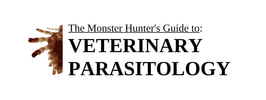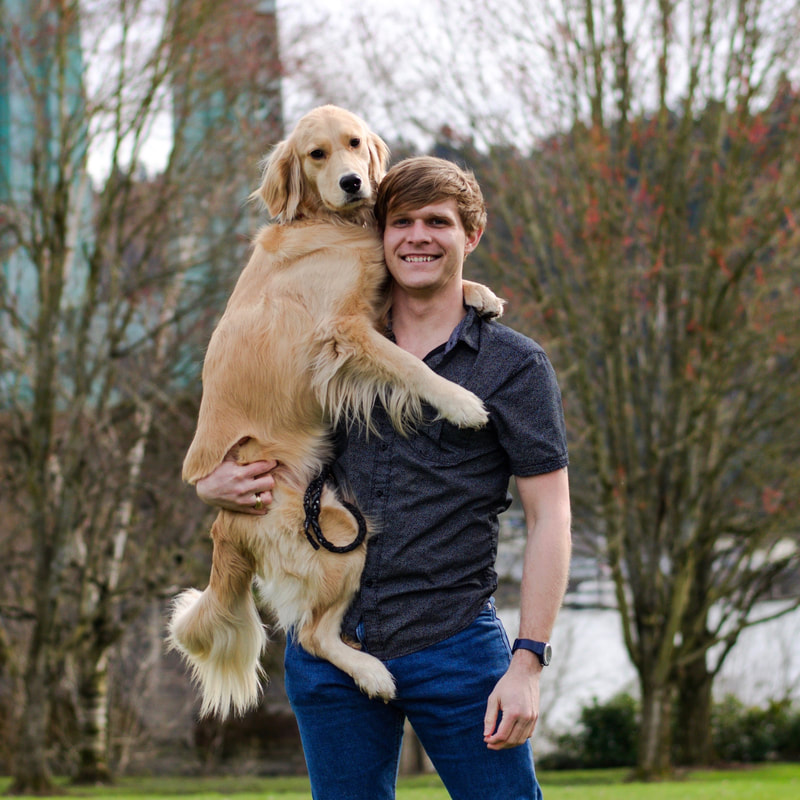Who made The Monster Hunter's Guide to Veterinary Parasitology?
Dr. Lance Wheeler is the owner and creator of The Monster Hunter's Guide to Veterinary Parasitology. Lance earned his veterinary degree at Texas A&M College of Veterinary Medicine. He is the owner, primary photographer, author, and web designer. He loves animals, parasites, veterinary medicine (especially emergency medicine and infectious diseases), microscopy, science fiction, funk and classical music.
Contributors:
- Kaitlan Hovis, DVM - Author and Photographer
- Michael W. Dryden DVM, PhD, DiplACVM - Photographer
- Selina Marie Zalesak, DVM - Photographer
- Chloe Chan Goodwin, DVM - Photographer
- Jillian Marie Athey, DVM - Photographer
- Jessica Leigh Wild, DVM - Photographer
Why did you make The Monster Hunter's Guide to Veterinary Parasitology?
As a kid, I (Lance Wheeler) was raised on an unhealthy diet of science fiction, action, and horror films. If I managed to stay out of trouble and finished all my chores, my parents would take me to the Blockbuster Video and allow me to rent nearly any movie I wanted. I understood that the Xenomorphs in Ridley Scott's Alien films were complex parasites, and I wondered how I could become a scientist who studied similar organisms. 20 years later, I was studying veterinary parasitology at Texas A&M. During my veterinary studies, I paid for several overpriced veterinary parasitology textbooks and I felt that all of them needed more images.
I began working on The Monster Hunter's Guide to Veterinary Parasitology because of my desire to:
I began working on The Monster Hunter's Guide to Veterinary Parasitology because of my desire to:
- Create a database of genuine monsters
- Contribute to the sum veterinary medical knowledge
- Contradict the rationale that information is available only to those who can afford it
What is the source of specimens and pictures?
Only a few of the specimens imaged in The Monster Hunter's Guide to Veterinary Parasitology are my (Lance Wheeler) property. The majority of the specimens in The Monster Hunter's Guide to Veterinary Parasitology were identified, preserved, and catalogued by veterinarians working in the departments of Veterinary Parasitology and Veterinary Pathology at The Texas A&M College of Veterinary Medicine & Biomedical Sciences. The departments of Veterinary Parasitology and Veterinary Pathology no longer exist as individual departments. Instead, these departments and others united to form the department of Veterinary Pathobiology. Dr. Karen Snowden of the department of Veterinary Pathobiology gave me permission to access her department's unique parasite collection. She trusted me with handling the specimens and allowed me to transport them for photographing. This resource would not be possible without the individuals who painstakingly collected, preserved, identified, and catalogued each and every one of those samples. Likewise, this resource would not exist if Dr. Snowden had not allowed me access to her department's collection. I am deeply grateful for all the efforts that made this resource possible.
The majority of the micrographs (i.e., digital images taken through a microscope) were taken using a microscope, camera, and computer that were lended to me by one of my mentors, Dr. Shannon Washburn of the department of Physiology & Pharmacology at The Texas A&M College of Veterinary Medicine & Biomedical Sciences. This resource would not be possible had Dr. Washburn not trusted me with her equipment.
Currently, every single image found on The Monster Hunter's Guide to Veterinary Parasitology was taken by either Lance Wheeler or Kaitlan Hovis. All of the images are copyrighted and should not be modified, reproduced, or distributed in any way without prior consent (see below).
Many of the micrographs seen in The Monster Hunter's Guide to Veterinary Parasitology are what I call focus-stacked micrographs. Focus stacking (aka., z-stacking, image stacking) is a digital image-processing technique used to increase the depth of field of a micrograph. Focus stacking allows one to combine (or superimpose) multiple micrographs, taken at different points of focus, into a single, focus-stacked micrograph in which all objects in the field of view are in crisp focus. The caption of every focus-stacked micrograph found in The Monster Hunter's Guide to Veterinary Parasitology indicates exactly how many micrographs were stacked to produce the single image. For example, if 20 micrographs were taken and stacked into a single, focus-stacked micrograph, then the caption will read, "Stack of 20 exposures."
The majority of the micrographs (i.e., digital images taken through a microscope) were taken using a microscope, camera, and computer that were lended to me by one of my mentors, Dr. Shannon Washburn of the department of Physiology & Pharmacology at The Texas A&M College of Veterinary Medicine & Biomedical Sciences. This resource would not be possible had Dr. Washburn not trusted me with her equipment.
Currently, every single image found on The Monster Hunter's Guide to Veterinary Parasitology was taken by either Lance Wheeler or Kaitlan Hovis. All of the images are copyrighted and should not be modified, reproduced, or distributed in any way without prior consent (see below).
Many of the micrographs seen in The Monster Hunter's Guide to Veterinary Parasitology are what I call focus-stacked micrographs. Focus stacking (aka., z-stacking, image stacking) is a digital image-processing technique used to increase the depth of field of a micrograph. Focus stacking allows one to combine (or superimpose) multiple micrographs, taken at different points of focus, into a single, focus-stacked micrograph in which all objects in the field of view are in crisp focus. The caption of every focus-stacked micrograph found in The Monster Hunter's Guide to Veterinary Parasitology indicates exactly how many micrographs were stacked to produce the single image. For example, if 20 micrographs were taken and stacked into a single, focus-stacked micrograph, then the caption will read, "Stack of 20 exposures."
Who identified the specimens?
As mentioned above, the majority of the specimens included in The Monster Hunter's Guide to Veterinary Parasitology were identified by veterinary parasitologists and pathologists at The Texas A&M College of Veterinary Medicine & Biomedical Sciences. The majority of these specimens were identified based on specimen morphology, host species, clinical presentation, known geographic distribution, etc. Very few of our specimens have been identified using molecular techniques. Therefore, The Monster Hunter's Guide to Veterinary Parasitology is not to be held responsible for any misidentification of organisms. Our goal is to have correctly identified every organism; however, we have neither the budget nor the authority to perform molecular tests for identification. If you find that we have inappropriately named any given organism, please help us improve this resource and contact us so that we can update our data accordingly.
Can I use any of the pictures on The Monster Hunter's Guide to Veterinary Parasitology?
All images with The Monster Hunter's Guide to Veterinary Parasitology logo are copyrighted through the U.S. Copyright Office. In addition, the caption of every image indicates the copyright holder, photographer, and sample owner. The following applies to all copyrighted images:
Please, contact us if you have any questions or concerns.
- No image found on The Monster Hunter's Guide to Veterinary Parasitology can be used for commercial purposes (without hand-written consent from Lance Ross Wheeler, the creator and owner of The Monster Hunter's Guide to Veterinary Parasitology).
- No image found on The Monster Hunter's Guide to Veterinary Parasitology can be used for any purpose that will result in financial gain of any sort (without hand-written consent from Lance Ross Wheeler, the creator and owner of The Monster Hunter's Guide to Veterinary Parasitology).
- No images found on The Monster Hunter's Guide to Veterinary Parasitology can be modified in any way (without hand-written consent from Lance Ross Wheeler, the creator and owner of The Monster Hunter's Guide to Veterinary Parasitology). All images must bear the logo/ watermark for The Monster Hunter's Guide to Veterinary Parasitology.
- Non-modified images from The Monster Hunter's Guide to Veterinary Parasitology may be used in educational lectures, presentations, or discussions of parasites and parasitic diseases. All borrowed images must bear the logo/ watermark for The Monster Hunter's Guide to Veterinary Parasitology. All borrowed images must include a legible link to www.veterinaryparasitology.com on the same page as the image.
- Non-modified images from The Monster Hunter's Guide to Veterinary Parasitology may be used in other educational projects that are intended only for education, and will not result in any direct or indirect financial gain. All borrowed images must bear the logo/ watermark for The Monster Hunter's Guide to Veterinary Parasitology. All borrowed images must include a legible link to www.veterinaryparasitology.com on the same page as the image.
Please, contact us if you have any questions or concerns.
What is the future of The Monster Hunter's Guide To Veterinary Parasitology?
Our current plans are to continue adding to the collection of parasites and to build upon the information that is provided about each organism. My ultimate goal is to make The Monster Hunter's Guide to Veterinary Parasitology a resource that will not only help with identifying organisms, but also provide clinical information about each organism (ex., host, life cycle, geographic distribution, epidemiology, diagnostics, treatment, control, etc). We will derive this information from only the most up-to-date, peer-reviewed articles, and all sources will be cited. As you can imagine, this is an ambitious goal, and it will not happen overnight. I have already poured thousands of hours and hundreds of dollars into this project.
The #1 piece of advice shared with me is that I need to profit financially from the work and time placed into this project; however, I intentionally and happily ignore this advice. Why? I want the users of The Monster Hunter's Guide to Veterinary Parasitology to know that this site was born from a love for parasitology, veterinary medicine, science, and the sum of knowledge of humanity; rather than being a project that is driven by the goal of monetary gain.
The #1 piece of advice shared with me is that I need to profit financially from the work and time placed into this project; however, I intentionally and happily ignore this advice. Why? I want the users of The Monster Hunter's Guide to Veterinary Parasitology to know that this site was born from a love for parasitology, veterinary medicine, science, and the sum of knowledge of humanity; rather than being a project that is driven by the goal of monetary gain.
How can I help?
Currently, nearly every aspect of this project is funded by me (Lance Wheeler), owner and creator of The Monster Hunter's Guide to Veterinary Parasitology. I have received no financial support for the production of The Monster Hunter's Guide to Veterinary Parasitology.
|
That being said, The Monster Hunter's Guide to Veterinary Parasitology needs money to run. Your donations will go towards paying for the annual subscription of the domain name, the annual subscription of the Weebly account, purchasing new parasite samples to be photographed and added to the database, and improving the functionality of the website (For example, Weebly will charge me only $5/month to add a comments section to every page, and I would pay for this if I could afford it). There are many parasite specimens, not already found on the site, that I would like to purchase and image. Your donation will help to expand the information made available on the site. Myself and Parasitologists around the world are grateful for your donation. Any individual who makes a donation will have their name placed on the "Make It Rain" list, along with a 1-2 sentence quote of their choosing. Please, leave your quote in the comment section when making your donation. Try to keep it clean or I'll have to do some editing.
|
|
$$$ MAKE IT RAIN $$$
- Eric Paulin (9/30/18) - "In a world where you can be anything, be kind." ***Premier Donor***
- Aline Rodrigues Hoffmann (6/25/18) - "Amazing website!"
- Al K. Dorris (6/23/18) - "Dude."
- Captain Jean-Luck Picard (6/20/18) - "No being is so important that he can usurp the rights of another."

